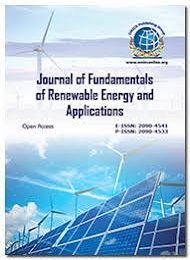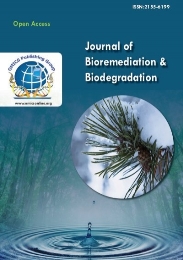Theme:
Green Energy 2021
Conference series llc Ltd welcomes you to attend the 9th World Congress and Expo on Green Energy during July 28-29, 2021 at London, UK. The relative novel nature of the conference is to bring the advancement in the field of utilization of natural resources. We cordially invite all the participants interested in sharing their knowledge and research in the arena of renewable energy and environmental sciences.
Green Energy Congress 2021 is the integration of new technologies in the field of environmental science to help Environmental Professionals harness the full potential of their practice. It involves the use of tools and technologies to achieve a certain degree of publicity and broaden the reach of the practice and the practitioner. The conference is a rare opportunity for all individuals of the environmental community to upgrade their know-how of the latest technologies & strategies
Why to attend?
Green Energy Congress 2021 has been designed with a twofold objective in mind. The main theme of the conference is "Share & acquire knowledge on utilization of natural resources” which covers a wide range of critically important sessions.
The event aims at bringing the advancement in the field of Green Energy, Renewable Energy, Environmental Science, and Green Technologies and also lays a special emphasis at Educating and informing environmental researcher, industry professionals with the latest knowledge of technologies that can be applied to counter the economic under-evaluation ecologist may face in their practice.
To add to its promise, the venue of the event has been selected after much research to assure that the event is being held in one of the hotspots for the concerned field, therefore attendance is expected to be astounding, both in quality and quantity. The variety of prospective audience includes: figures of academic excellence, interested industrialists, Students, exhibitors and eminent faces from the world of marketing thus enabling the sponsors a unique chance to choose from a pool of outstanding scopes for expansion of their business, new project undertaking and recruitment. All these factors combined and several more make Green Energy Congress 2021 a “must attend” green energy conference.
A Unique Opportunity for Advertisers and Sponsors at this International event.
For sponsorship opportunities:
https://greenenergy.environmentalconferences.org/sponsors.php
Track 1: Green Energy
Green Energy principally involves natural energetic processes which are able to be controlled with little or no pollution. Anaerobic digestion, geothermal power, wind power, small-scale hydropower, alternative energy, biomass power, recurrent event power, wave power, and many sorts of nuclear power belongs to the green energy. Some definitions might embody power derived from the combustion of waste. In several countries with enterprise arrangements, electricity selling arrangements build it attainable for patrons to shop for green electricity from either their utility or a green power provider. Once energy is purchased from the electricity network, the power reaching the customer will not primarily be generated from green energy sources. The native utility company, utility, or state power pool buys their electricity from electricity producers World Health Organization might even be generating from fuel, nuclear or renewable energy sources. In many countries green energy presently provides a very little bit of electricity, typically conducive two to five to the pool. green energy customers either obligates the utility firms to increase the number of inexperienced energy that they purchase from the or directly fund the green energy through a green power provider.
Related Societies:
Europe : Danish Organisation for Renewable Energy, European Renewable Energy Council, Green Power Forum, INFORSE-Europe, International Renewable Energy Agency, Renewable Energy and Energy Efficiency Partnership, World Council for Renewable Energy, European Wind Energy Association, RenewableUK, EKOenergy
USA: American Council on Renewable Energy, American Solar Energy Society, American Wind Energy Association, Florida Solar Energy Centre, Environmental and Energy Study Institute
Asia: Agency for Non-conventional Energy and Rural Technology, IRENA – The International Renewable Energy Agency (Abu-Dhabi)
Related Journals: International Journal of Green Energy, Energy and Environmental Sciences, International Journal of Sustainable and Green Energy, Trends in Green Chemistry
Track 2:- Renewable Energy
Renewable Energy comes from non-conventional energy that is continuously replenished by natural processes. It’s attracted plenty of attention within the recent past due to exhaustion of fossil fuels and within the lookout for alternate energy for a clean and green future. Totally different varied kinds of renewable energy embody solar power, wind energy, hydro energy, heat energy, wave and tidal energy. Supported the report of REN21's 2014, renewable contributed 19 % to our energy consumption and 22 % to our electricity generation in 2012 and 2013. Renewable power is cost effective, reliable, property, and environmentally friendly. Recently the renewable energy sector is already providing quite 450,000 jobs associated has an annual turnover exceeding 45 billion Euros. Since 2009, 25 solar projects totalling quite 8,000 megawatts, and 9 wind comes totalling quite 4,000 megawatts, are approved on public lands within the U.S. That’s enough electricity to power nearly four million yankee homes. The worldwide renewable energy market (excluding biofuels) reached $432.7 billion in 2013 and $476.3 billion in 2014. This market is predicted to extend to $777.6 billion in 2019, with a compound annual rate of growth (CAGR) of 10.3% from 2014 to 2019.
Related Societies:
Europe : Danish Organisation for Renewable Energy, European Renewable Energy Council, Green Power Forum, INFORSE-Europe, International Renewable Energy Agency, Renewable Energy and Energy Efficiency Partnership, World Council for Renewable Energy, European Wind Energy Association, RenewableUK, EKOenergy
USA: American Council on Renewable Energy, American Solar Energy Society, American Wind Energy Association, Florida Solar Energy Centre, Environmental and Energy Study Institute
Asia: Agency for Non-conventional Energy and Rural Technology, IRENA – The International Renewable Energy Agency (Abu-Dhabi)
Related Journals: International Journal of Green Energy, Energy and Environmental Sciences, International Journal of Sustainable and Green Energy, Trends in Green Chemistry
Track 3: Green Nanotechnology
Green nanotechnology typically refers to the use of applied science to strengthen the environmental property of processes producing negative externalities. It to boot refers to the employment of the product of applied science to strengthen property. It includes making inexperienced Nano-products and exploitation Nano-products in support of property. Green applied science has been depicted as a result of the event of recent technologies, to attenuate potential environmental and human health risks associated with the manufacture and use of nanotechnology product, and to encourage replacement of existing product with new Nano-products that square measure further surroundings friendly throughout their lifecycle producing nanomaterial’s and products whereas not harming the surroundings or human health, and producing Nano-products that supply solutions to environmental problems. It uses existing principles of green chemistry and green engineering to make nanomaterials and Nano-products whereas not toxic ingredients, at low temperatures pattern less energy and renewable inputs wherever potential and pattern lifecycle thinking all told style and engineering stages.
Related Societies:
Europe : Danish Organisation for Renewable Energy, European Renewable Energy Council, Green Power Forum, INFORSE-Europe, International Renewable Energy Agency, Renewable Energy and Energy Efficiency Partnership, World Council for Renewable Energy, European Wind Energy Association, RenewableUK, EKOenergy
USA: American Council on Renewable Energy, American Solar Energy Society, American Wind Energy Association, Florida Solar Energy Centre, Environmental and Energy Study Institute
Asia: Agency for Non-conventional Energy and Rural Technology, IRENA – The International Renewable Energy Agency (Abu-Dhabi)
Related Journals: International Journal of Green Energy, Energy and Environmental Sciences, International Journal of Sustainable and Green Energy, Trends in Green Chemistry
Track 4:- Green Processing and Solar Energy
Green process and Synthesis could be a bimonthly, peer-reviewed journal that gives up-to-date analysis each on basic as well as applied aspects of innovative green method development and chemical synthesis, giving an appropriate share to industrial views. The contributions are innovative, high-impact, authoritative, and supply each professionals and cons of potential technologies. Green process and Synthesis provides a platform for scientists and engineers, particularly chemists and chemical engineers, however is also open for knowledge base analysis from alternative areas like physics, materials science, or chemical process. The Novel water-borne coatings via hybrid mini emulsion polymerisation area unit extremely getting used and for pollution bar within the storage device business the data of this subject is incredibly necessary. For Eliminating solvents and acids in wafer process yet as Qualitative and measurement for environmentally benign electroplating operations ought to be done well. The solar power is in action these days and incorporates a nice impact on the energy resources.
Related Societies:
Europe : Danish Organisation for Renewable Energy, European Renewable Energy Council, Green Power Forum, INFORSE-Europe, International Renewable Energy Agency, Renewable Energy and Energy Efficiency Partnership, World Council for Renewable Energy, European Wind Energy Association, RenewableUK, EKOenergy
USA: American Council on Renewable Energy, American Solar Energy Society, American Wind Energy Association, Florida Solar Energy Centre, Environmental and Energy Study Institute
Asia: Agency for Non-conventional Energy and Rural Technology, IRENA – The International Renewable Energy Agency (Abu-Dhabi)
Related Journals: International Journal of Green Energy, Energy and Environmental Sciences, International Journal of Sustainable and Green Energy, Trends in Green Chemistry
Track 5: Environmental Engineering
Environmental Engineering involves applying science and engineering practices to how we tend to utilize and impact our natural resources. Trendy environmental engineers work on solutions to problems like pollution reduction and pack up, energy consumption and emissions, land erosion, water treatment and waste management in a shot to properly manage and maintain the standard of our soil, water and air. By action the event of third generation catalysts, this volume presents trends and opportunities in tutorial and industrial analysis.
Related Societies:
Europe : Danish Organisation for Renewable Energy, European Renewable Energy Council, Green Power Forum, INFORSE-Europe, International Renewable Energy Agency, Renewable Energy and Energy Efficiency Partnership, World Council for Renewable Energy, European Wind Energy Association, RenewableUK, EKOenergy
USA: American Council on Renewable Energy, American Solar Energy Society, American Wind Energy Association, Florida Solar Energy Centre, Environmental and Energy Study Institute
Asia: Agency for Non-conventional Energy and Rural Technology, IRENA – The International Renewable Energy Agency (Abu-Dhabi)
Related Journals: International Journal of Green Energy, Energy and Environmental Sciences, International Journal of Sustainable and Green Energy, Trends in Green Chemistry
Track 6: Sustainable energy Policies
Renewable energy and energy efficiency are typically aforementioned to be the "twin pillars" of property energy policy. Each resource ought to be developed so as to stabilize and cut back oxide emissions. There are various energy policies on a worldwide scale in relation to energy exploration, production and consumption, ranging from commodities companies to automobile manufacturers to wind and star producers and business associations. Recent focus of energy economic science includes the next issues: temperature change and climate policy, property, energy markets and process, political economy of energy infrastructure, energy and environmental law and policies and warming alongside exploring varied challenges associated with quick the diffusion of renewable energy technologies in developing countries. Most of the agricultural facilities at intervals the developed world are mechanized as a result of rural electrification. Rural electrification has created necessary productivity gains; however it additionally uses lots of energy. For this and various reasons (such as transport costs) throughout a low-carbon society, rural areas would want obtainable provides of renewably created electricity.
Related Societies:
Europe : Danish Organisation for Renewable Energy, European Renewable Energy Council, Green Power Forum, INFORSE-Europe, International Renewable Energy Agency, Renewable Energy and Energy Efficiency Partnership, World Council for Renewable Energy, European Wind Energy Association, RenewableUK, EKOenergy
USA: American Council on Renewable Energy, American Solar Energy Society, American Wind Energy Association, Florida Solar Energy Centre, Environmental and Energy Study Institute
Asia: Agency for Non-conventional Energy and Rural Technology, IRENA – The International Renewable Energy Agency (Abu-Dhabi)
Related Journals: International Journal of Green Energy, Energy and Environmental Sciences, International Journal of Sustainable and Green Energy, Trends in Green Chemistry
Track 7: Bio-fuel
Biofuels are created from living organisms or from metabolic by-products (organic or waste products) instead of a fuel created by natural science processes like those involved among the formation of fossil fuels, like coal and crude. Biodiesel is also a form of diesel fuel ready-made from vegetable oils, animal fats, or recycled building greases. It is safe, perishable, and produces less air pollutants than petroleum-based diesel. Biodiesel are typically utilised in its pure kind (B100) or mingling with crude diesel. Common blends embody B2 (2% biodiesel), B5, and B20.The 93 billion litters of biofuels created worldwide in 2009 displaced the equivalent of academic degree derived sixty eight billion litters of gas, up to regarding 5-hitter of world gas production. Two most common types of biofuels used are plant product and biodiesel are derived from gift plants, alcohol and oil that act as a perfect substitute for fuel.
Related Societies:
Europe : Danish Organisation for Renewable Energy, European Renewable Energy Council, Green Power Forum, INFORSE-Europe, International Renewable Energy Agency, Renewable Energy and Energy Efficiency Partnership, World Council for Renewable Energy, European Wind Energy Association, RenewableUK, EKOenergy
USA: American Council on Renewable Energy, American Solar Energy Society, American Wind Energy Association, Florida Solar Energy Centre, Environmental and Energy Study Institute
Asia: Agency for Non-conventional Energy and Rural Technology, IRENA – The International Renewable Energy Agency (Abu-Dhabi)
Related Journals: International Journal of Green Energy, Energy and Environmental Sciences, International Journal of Sustainable and Green Energy, Trends in Green Chemistry
Track 8: Bio-remediation
Bioremediation is also a waste management technique that involves the use of organisms to induce eliminate or neutralize pollutants from a contaminated site. Technologies are going to be sometimes classified as in situ or ex situ. in situ bioremediation also involves treating the contaminated material at the location, whereas ex situ involves the removal of the contaminated material to be treated elsewhere. Bioremediation would possibly occur on its own (natural attenuation or intrinsic bioremediation) or may exclusively effectively occur through the addition of fertilizers, oxygen, etc., that facilitate encourage the growth of the pollution-eating microbes at intervals the medium. However, not all contaminants unit of measurement merely treated by bioremediation using microorganisms. Phytoremediation is useful in these circumstances as results of natural plants or transgenic plants unit of measurement able to bio-accumulate these toxins in their above-ground parts, that unit of measurement then harvested for removal.’
Related Societies:
Europe : Danish Organisation for Renewable Energy, European Renewable Energy Council, Green Power Forum, INFORSE-Europe, International Renewable Energy Agency, Renewable Energy and Energy Efficiency Partnership, World Council for Renewable Energy, European Wind Energy Association, RenewableUK, EKOenergy
USA: American Council on Renewable Energy, American Solar Energy Society, American Wind Energy Association, Florida Solar Energy Centre, Environmental and Energy Study Institute
Asia: Agency for Non-conventional Energy and Rural Technology, IRENA – The International Renewable Energy Agency (Abu-Dhabi)
Related Journals: International Journal of Green Energy, Energy and Environmental Sciences, International Journal of Sustainable and Green Energy, Trends in Green Chemistry
Track 9: Green Economy
Green economy will be defined as an economy that aims at reducing environmental risks and ecological scarcities that aims for property development whereas not degrading the atmosphere in keeping with the UN setting Programme. It closely connected with ecological political economy, but contains lots of politically applied focus. A green economy is thought of together that's low carbon, resource economical and socially comprehensive. It closely connected with ecological political economy, but contains lots of politically applied focus. A low-carbon economy in addition referred to as low-fossil-fuel economy, or decarbonized economy is an economy supported low carbon power sources that so contains a negligible output of greenhouse gas emissions into the setting region, but specifically refers to the greenhouse gas CO2. Greenhouse gas emissions as a results of human activity unit more and more either inflicting warming or making world global climate change worse.
Related Societies:
Europe : Danish Organisation for Renewable Energy, European Renewable Energy Council, Green Power Forum, INFORSE-Europe, International Renewable Energy Agency, Renewable Energy and Energy Efficiency Partnership, World Council for Renewable Energy, European Wind Energy Association, RenewableUK, EKOenergy
USA: American Council on Renewable Energy, American Solar Energy Society, American Wind Energy Association, Florida Solar Energy Centre, Environmental and Energy Study Institute
Asia: Agency for Non-conventional Energy and Rural Technology, IRENA – The International Renewable Energy Agency (Abu-Dhabi)
Related Journals: International Journal of Green Energy, Energy and Environmental Sciences, International Journal of Sustainable and Green Energy, Trends in Green Chemistry
Track 10: Climate Change and Renewable Energy
All energy sources have some impact on our environment. Fossil fuels-coal, oil, and natural gas-do substantially more harm than renewable energy sources by most measures, including air and water pollution, damage to public health, wildlife and habitat loss, water use, land use, and global warming emissions. Renewable energy is one of the most effective tools we have in the fight against climate change, and there is every reason to believe it will succeed. A recent New York Times column seems to imply that renewable energy investments set back efforts to address climate change nothing could be further from the truth. What’s more, renewable technologies can increasingly save customers money as they displace emissions from fossil fuels. Wind and solar energy have experienced remarkable growth and huge cost improvements over the past decade with no signs of slowing down. Prices are declining rapidly, and renewable energy is becoming increasingly competitive with fossil fuels all around the country. In some places, new renewable energy is already cheaper than continuing to operate old, inefficient and dirty fossil fuel-fired or nuclear power plants.
Related Societies:
Europe : Danish Organisation for Renewable Energy, European Renewable Energy Council, Green Power Forum, INFORSE-Europe, International Renewable Energy Agency, Renewable Energy and Energy Efficiency Partnership, World Council for Renewable Energy, European Wind Energy Association, RenewableUK, EKOenergy
USA: American Council on Renewable Energy, American Solar Energy Society, American Wind Energy Association, Florida Solar Energy Centre, Environmental and Energy Study Institute
Asia: Agency for Non-conventional Energy and Rural Technology, IRENA – The International Renewable Energy Agency (Abu-Dhabi)
Related Journals: International Journal of Green Energy, Energy and Environmental Sciences, International Journal of Sustainable and Green Energy, Trends in Green Chemistry
Track 11:- Energy and Environment
Energy and Environment co-related within the technological and scientific aspects as well as energy conservation, and also the interaction of energy forms and systems with the physical setting. The degree of atmospherically greenhouse gas has enlarged by 31st between 1800 and 2000, going from 280 parts per million to 367 parts per million. Scientists predict that greenhouse gas levels may well be as high as 970 parts per million by the year 2100. Various factors are liable for this development, like progress with respect to technical parameters of energy converters, especially, improved efficiency; emissions characteristics and increased life. Numerous environmental policies are enforced across the world for reduction of GHG emissions for improvement of environment.
Related Societies:
Europe : Danish Organisation for Renewable Energy, European Renewable Energy Council, Green Power Forum, INFORSE-Europe, International Renewable Energy Agency, Renewable Energy and Energy Efficiency Partnership, World Council for Renewable Energy, European Wind Energy Association, RenewableUK, EKOenergy
USA: American Council on Renewable Energy, American Solar Energy Society, American Wind Energy Association, Florida Solar Energy Centre, Environmental and Energy Study Institute
Asia: Agency for Non-conventional Energy and Rural Technology, IRENA – The International Renewable Energy Agency (Abu-Dhabi)
Related Journals: International Journal of Green Energy, Energy and Environmental Sciences, International Journal of Sustainable and Green Energy, Trends in Green Chemistry
Track 12:- Waste to Energy
Waste-to-energy (WtE) is the process of generating energy in the form of electricity and/or heat from the primary treatment of waste, or the processing of waste into a fuel source. WtE is a form of energy recovery. Most WtE processes generate electricity and/or heat directly through combustion, or produce a combustible fuel commodity, such as methane, methanol, ethanol or synthetic fuels. The term WtE is commonly used in specific reference to incineration which burns completely combusted waste at ultra-high temperatures allowing for energy recovery. Modern incineration facilities use pollution control equipment to prevent the release of emissions into the environment. Currently incineration is the only WtE technology that is economically viable and operationally feasible at commercial scale.
Related Societies:
Europe : Danish Organisation for Renewable Energy, European Renewable Energy Council, Green Power Forum, INFORSE-Europe, International Renewable Energy Agency, Renewable Energy and Energy Efficiency Partnership, World Council for Renewable Energy, European Wind Energy Association, RenewableUK, EKOenergy
USA: American Council on Renewable Energy, American Solar Energy Society, American Wind Energy Association, Florida Solar Energy Centre, Environmental and Energy Study Institute
Asia: Agency for Non-conventional Energy and Rural Technology, IRENA – The International Renewable Energy Agency (Abu-Dhabi)
Related Journals: International Journal of Green Energy, Energy and Environmental Sciences, International Journal of Sustainable and Green Energy, Trends in Green Chemistry
Track 13:- Recycling Renewables
Recycling is directly connected to renewable energy as it helps in sustaining the natural resources of the earth. With the hype about recycling reaching every nook and corner of the world, there are many organizations, which have volunteered to take on recycling. Many products have been launched to facilitate proper recycling process. You don’t have to be a futurist to imagine a green energy landscape populated by rows of rotating wind turbines, fields of sparkling solar panels, and smooth-running, silent electric cars. Indeed, that utopian vision is almost within reach. But if the materials that enable those technologies aren’t reclaimed, the future’s clean energy will be anything but, with views marred by graveyards of old turbine blades, decrepit solar panels, and corroding batteries. Many initiatives are under way to prepare for the arrival of this new type of waste. But in most cases, the solutions are works in progress at best. The potential quantities of waste are enormous. By 2025, waste batteries removed from electric vehicles will total 95 gig watt hours’ worth, according to an estimate by Bloomberg New Energy Finance. That pile will weigh roughly 600,000 metric tons.
Track 14:- Climate Change and Renewable Energy
All energy sources have some impact on our environment. Fossil fuels-coal, oil, and natural gas-do substantially more harm than renewable energy sources by most measures, including air and water pollution, damage to public health, wildlife and habitat loss, water use, land use, and global warming emissions. Renewable energy is one of the most effective tools we have in the fight against climate change, and there is every reason to believe it will succeed. A recent New York Times column seems to imply that renewable energy investments set back efforts to address climate change nothing could be further from the truth. What’s more, renewable technologies can increasingly save customers money as they displace emissions from fossil fuels. Wind and solar energy have experienced remarkable growth and huge cost improvements over the past decade with no signs of slowing down. Prices are declining rapidly, and renewable energy is becoming increasingly competitive with fossil fuels all around the country. In some places, new renewable energy is already cheaper than continuing to operate old, inefficient and dirty fossil fuel-fired or nuclear power plants.
To share your views and research, please click here to register for the Conference.
To Collaborate Scientific Professionals around the World
| Conference Date | July 28-29, 2021 | ||
| Sponsors & Exhibitors |
|
||
| Speaker Opportunity Closed | |||
| Poster Opportunity Closed | Click Here to View | ||
Useful Links
Special Issues
All accepted abstracts will be published in respective Our International Journals.
- Journal of Fundamentals of Renewable Energy and Applications
- Journal of Bioremediation & Biodegradation
- Expert Opinion on Environmental Biology
Abstracts will be provided with Digital Object Identifier by



































